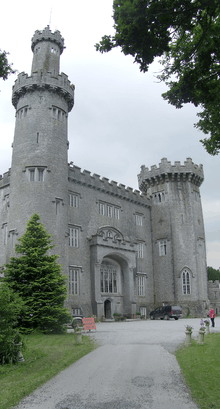Charleville Castle
Coordinates: 53°15′25″N 7°31′36″W / 53.257000°N 7.526780°W

Charleville Forest Castle is a Gothic-style castle located in County Offaly, Ireland, bordering the town of Tullamore, near the Shannon River. It is considered one of the finest of its type in the country.[1]
History
The land where the Charleville estate and castle were created is situated in Ireland's most ancient primordial oak woods, once the haunting grounds of Ireland's druids. In the 6th century it was part of the ancient monastic site of Lynally, which itself was in the ancient Durrow monastic settlement.
Later, in the early days of Ireland's colonisation, when the city of Dublin felt threatened by the wild tribes of the West, these lands became the focal point for the first Marian, and later more violent Elizabethan, plantations. By the mid-1500s the lands that were originally ruled by the O'Molloy clan were securely "planted" and in the hands of the Moore family. From this point on a dynasty was established which endured into the late nineteenth century, commencing with the grant of the Tullamore area, comprising some 5000 acres, to Sir John Moore in 1622. At that time the Tullamore estate included a ruined castle, ten cottages and two water mills. Sir Robert Forth, who leased the lands from Thomas Moore (son and heir of Sir John), built a mansion house c.1641 in what is now the Charleville demesne. Charles Moore, Lord Tullamore, grandson of Thomas, eventually regained possession of the estate and when he died in 1674 it went via his sister to Charles William Bury. Charles William was later (1806) created the 1st Earl of Charleville in a second creation of the title.[2]
The new earl decided to build a new house on the estate. Charleville Castle grew from paper doodles in early 1798 to grandiose plans by the end of that very eventful year in Ireland. It was designed by Francis Johnston, one of the leading architects of the day who also designed the GPO in Dublin, and built between 1800 and 1809. It owes its "Tin Soldier Fortress" look to the celebration of victory over the third French revolutionary expedition to Ireland – the first decisive victory by Britain over the revolutionary republican movement, which was sweeping across the monarchies and their colonies at that time. It took fourteen years to complete this gothic dream, a monument not only to a now forgotten power, but also to the people who made it possible, the Irish craftsmen and impoverished people.
The castle had to be temporarily closed at times, due to the castle owners living beyond their means. However, each subsequent re-opening was usually marked by a suitably flamboyant gesture, which included engaging the talents of William Morris, who designed the ceiling within the dining room. Additionally, Charleville is said to have helped start a craze of building castles within Ireland.
The castle played host to Lord Byron, who held many parties here. In fact, whenever he visited Ireland he always went to the castle. This was due to the castle owner's eccentricity.
The castle remained uninhabited from 1912, during the difficult years of the independence war and the long years of economic severity which followed. By 1968 the roof had been removed. It had become a part of "Vanishing Ireland" until finally work on its restoration was commenced by Michael McMullen in 1971 and later by Constance Heavey Seaquist and Bonnie Vance. A Charitable Trust has been formed to help with the restoration.
It is said to be haunted by a girl who got lost and went up the tallest tower. She then went sliding down but fell off and broke her neck. A photographer went up the tower but only his camera was ever found.[citation needed]
Present day
Currently, the Charleville Castle Heritage Trust is managed by Dudley Stewart. The day-to-day running is handled by volunteers, who come from countries including France, Canada, the United States of America and the United Kingdom, as well as other parts of Ireland to help out at the castle. The castle itself is reputed to be haunted, with it appearing on Living TV's Most Haunted and Fox's Scariest Places on Earth. It has also been visited by numerous paranormal investigators and psychics. Guests of the castle have reported strange goings on at the castle as well. The castle has been photographed by Sir Simon Marsden and appeared within his collections.
The castle has been host to multiple events, including "fright nights", an auction and a play by the English Chamber Theatre called Dearest Nancy, Darling Evelyn. More recently, it has played host to the Mór Festival, and its successor, Castlepalooza.
The castle has also been investigated by many paranormal investigation groups from around the world, though it seems that only within the past 2–3 years that it has been investigated by Irish paranormal groups.
It was on ABC Family's Scariest Places on Earth. It also appeared on Ghost Hunters International. It was also used as a filming location for Becoming Jane (2007)[3][4] and Northanger Abbey (2007).
References
- ↑ Craig, Maurice; The Knight of Glin (1969). Ireland Observed. Cork: Mercier Press. p. 29. ISBN 978-0-85342-049-1.
- ↑ "Charleville Demesne & The Burys, 1600–1900". Retrieved 15 December 2012.
- ↑ "Lights, camera and a tidy €450m in tourism". Irish Independent. 3 September 2007. Retrieved 26 July 2012.
- ↑ "Filming in Ireland". Irish Film Board. Retrieved 26 July 2012.
Related links
- Official website
- Collection Of Images from 2006
- IMDb filming locations
- Description, history and pictures of Charleville Castle